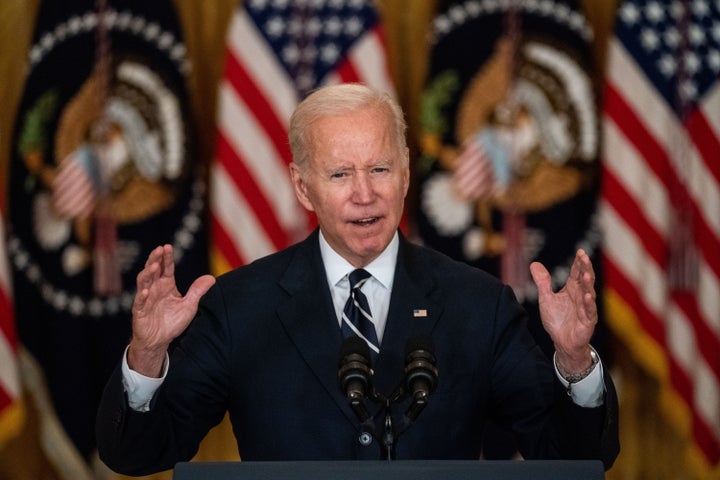
Just a week after fossil fuel stalwarts in his own party killed his signature carbon-cutting proposal, President Joe Biden announced Thursday a compromise package that, if passed, would mark by far the biggest climate investment in U.S. history.
The proposal directs $550 billion of Democrats’ $1.75 trillion Build Back Better Act toward the nation’s buildout of zero-carbon electricity, electric vehicles and pollution cleanups.
In a speech Thursday afternoon, Biden called the framework “the most significant investment to deal with the climate crisis [to have] ever, ever happened ― beyond any other advanced nation in the world.”
“Over a billion metric tons of emissions reductions ― at least 10 times bigger on climate than any bill that has ever passed before and enough to position us for a 50 to 52% emissions reductions by the year 2030,” he said. “And we’ll do it in ways that grow the domestic industries, create good-paying union jobs, and address longstanding environmental injustices, as well.”
On a dollar-for-dollar basis, the plan dwarfs the last major federal climate investment, a $90 billion package then-President Barack Obama won in 2009, and gives the White House leverage to demand that the rest of the world take drastic action to curb climate-changing pollution when the president arrives next week in Glasgow, Scotland, for the big United Nations climate summit.

But the package falls far short of what scientists and economists from across the ideological spectrum say is needed to transform the U.S. economy and keep warming from soaring to catastrophic levels. Coupled with a lackluster emissions-cutting pledge from China, the U.S. proposal stoked fears the world will fail to cut pollution fast enough to keep global temperatures from surging past 1.5 degrees Celsius, or 2.7 degrees Fahrenheit, routinely causing trillions of dollars in damages and millions of early deaths.
“It is easy to call this the biggest climate bill ever when the federal government has done so little to protect people from the unfolding crisis, and when our democracy is so polluted by the influence of fossil fuel lobbyists,” Janet Redman, Greenpeace USA’s climate campaign director, said in a statement. “The bar for action cannot be set by what pundits deem possible or by the accomplishments of past administrations — it must be set by science and justice.”
The proposal, which is almost certain to receive zero votes from Republican lawmakers, will require every Democratic senator and virtually all House Democrats to become law. Progressives, who had wanted a $10 trillion plan in line with projections for what is needed for full decarbonization, have said they are waiting to see the final text of the legislation before guaranteeing their votes.
The deal, according to a factsheet the White House published Thursday morning, includes about $320 billion in tax credits for companies that buy and build solar, wind and nuclear power, and for drivers who purchase electric vehicles. The program would last 10 years ― twice as long as previous clean energy tax credits.
Another $105 billion would go to investments to fortify the country against extreme weather, clean up disease-causing chemicals in historically polluted communities, and set up a Civilian Climate Corps modeled on the New Deal-era Civilian Conservation Corps, which planted billions of trees and provided jobs during the Great Depression.
The administration said it won $110 billion in targeted incentives to boost domestic manufacturing of clean energy products and baseline industrial goods such as cement and steel, which have struggled to compete with cheaper and often more polluting rivals overseas.
“It is easy to call this the biggest climate bill ever when the federal government has done so little to protect people from the unfolding crisis, and when our democracy is so polluted by the influence of fossil fuel lobbyists.”
- Janet Redman, Greenpeace USA
The budget also includes $20 billion for the government itself to buy more green technologies, including small-modular nuclear reactors, which could have a knock-on effect of spurring on technologies that have had trouble finding private buyers.
Nearly half the country’s emissions come from automobile tailpipes, office furnaces, and home stovetops, and eliminating that pollution means swapping those cars, heating and cooking systems for electric alternatives. Doing so, according to a 2018 study from the National Renewable Energy Laboratory, would increase U.S. electricity consumption by 40% over the next three decades.
The investments in the White House’s budget deal will undoubtedly hasten the transition to electric vehicles and appliances, and increase the likelihood that zero-carbon sources make up a large portion of new power generation. But the U.S. had nearly 200 new gas-fired power plants under construction or in the permitting phase just two years ago, and the plan does little to explicitly limit fossil fuel use.
That was by design. Sen. Joe Manchin (D-W.Va.), a conservative Democrat from a major fossil fuel-producing state and whose family owns a coal business, balked at the regulatory program that was supposed to serve as the centerpiece of Biden’s climate strategy.
The proposed Clean Electricity Performance Program would have given the Department of Energy $150 billion to pay utilities who increase their output of zero-carbon power by 4% each year ― and fine those that failed to hit that target.
Just two utilities ― the municipally owned Orlando Utility Commission in Florida and Southern Indiana Gas & Electric ― were on track to meet that target, according to company data the advocacy groups Evergreen Action and Natural Resources Defense Council collected. That made the provision key to hitting emissions goals. Independent modelers projected the program would get the U.S. one-third of the way to its goal of cutting emissions in half by the end of this decade.
Democrats managed to redistribute that funding to other programs, delivering a much bigger tax credit suite than previously planned. That’s a lot of carrots. And the administration has vowed to compensate for the loss of the program by enacting new regulations at the Environmental Protection Agency, restoring the federal government’s stick.
A new analysis by the Rhodium Group, a consultancy firm, found that the mix of funding and executive branch actions could, technically, deliver the emissions cuts Biden promised. (New modeling from independent consultancies that includes the beefed-up spending on tax credits and other climate provisions is expected in the coming days).
The implementation of the climate plan comes with big ifs. Regulations will take years to come into force, and will likely face hefty legal challenges like the ones that met the Obama administration’s proposed rules after the 44th president similarly failed to codify a decarbonization plan into law through Congress. Unlike then, the federal judiciary is now stacked with judges former President Donald Trump, a fossil fuel hardliner, named to the bench, and conservatives enjoy a 6-3 majority on the Supreme Court. And if Biden, already the oldest person to assume the presidency, is defeated in 2024, the next administration could reverse the regulatory and executive actions almost as easily as the current White House enacted them.
The Biden administration already received a taste of that reality in June. Shortly after fulfilling a campaign promise to pause oil and gas leasing on federal lands, Judge Terry Doughty of the U.S. District Court for the Western District of Louisiana, a Trump appointee, issued a ruling lifting the temporary leasing halt.
On Nov. 17, just five days after the U.N. climate summit is scheduled to end, Biden’s Department of the Interior is set to auction some 80 million acres of the Gulf of Mexico to oil and gas drillers.
